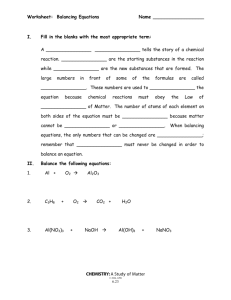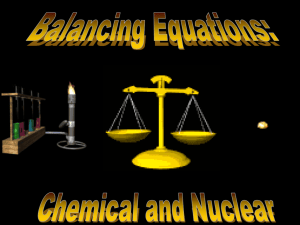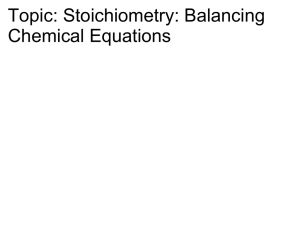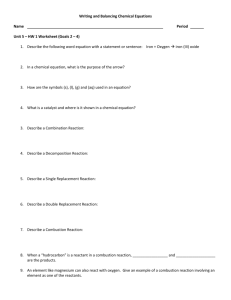Balancing Chemical Equations
advertisement
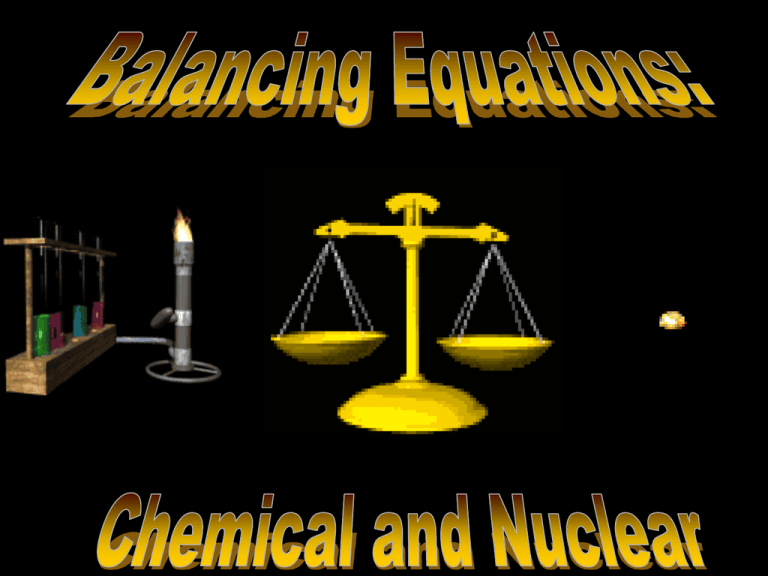
How molecules are symbolized Cl2 2Cl 2Cl2 • Molecules may also have brackets to indicate numbers of atoms. E.g. Ca(OH)2 • Notice that the OH is a group O Ca O H • The 2 refers to both H and O H • How many of each atom are in the following? a) NaOH Na = 1, O = 1, H = 1 b) Ca(OH)2 Ca = 1, O = 2, H = 2 c) 3Ca(OH)2 Ca = 3, O = 6, H = 6 Balancing equations: MgO Dalton: chemical reactions are the result of a rearrangement of atoms. Lavoisier: Conservation of Mass – “What goes in must come out” Number and types of atoms must be conserved. Thus, the number of a particular atom is the same on both sides of a chemical equation • Example: Magnesium + Oxygen Mg + O2 MgO Mg + O O • However, this is not balanced • Left: Mg = 1, O = 2 • Right: Mg = 1, O = 1 Mg O Representing Reactions Word Equation: Magnesium + hydrochloric acid magnesium chloride + hydrogen Skeleton Equation: Mg (s) + HCl (aq) H2 (g) + MgCl2 (aq) When going from word equations to skeleton equations, don’t forget about HOBrFINCl gases! Balancing Equation Guidelines: 1. Balance the element with the greatest number of atoms (not H or O!) 2. Balance other elements in compounds. If an element is uncombined, usually leave it until last. 3. Balance H or O, if they are combined in compounds 4. Balance uncombined elements 5. Check a) P4 + 5 O2 P4O10 b) 2 Li + 2 H2O H2 + 2 LiOH c) 2 Bi(NO3)3 + 3 K2S Bi2S3 + 6 KNO3 d) C2H6 +3.5 O2 2 CO2 + 3 H2O 2 C2H6 + 7 O2 4 CO2 + 6 H2O Balance these skeleton equations: a) b) c) d) e) f) g) h) i) Mg + HCl MgCl2 + H2 Ca + N2 Ca3N2 NH4NO3 N2O + H2O BiCl3 + H2S Bi2S3 + HCl C4H10 + O2 CO2 + H2O O2 + C6H12O6 CO2 + H2O NO2 + H2O HNO3 + NO Cr2(SO4)3+ NaOH Cr(OH)3+ Na2SO4 Al4C3 + H2O CH4 + Al(OH)3 Balance these skeleton equations: a) b) c) d) e) f) g) h) i) Mg + 2HCl MgCl2 + H2 3Ca + N2 Ca3N2 NH4NO3 N2O + 2H2O 2BiCl3 + 3H2S Bi2S3 + 6HCl 2C4H10 + 13O2 8CO2 + 10H2O 6O2 + C6H12O6 6CO2 + 6H2O 3NO2 + H2O 2HNO3 + NO Cr2(SO4)3+ 6NaOH 2Cr(OH)3+ 3Na2SO4 Al4C3 + 12H2O 3CH4 + 4Al(OH)3 Returning to reaction types • We have looked at several types of reactions without worrying about balancing • However, all equations should be balanced • Predict the products and balance these: (recall, metals above replace metals below, reactions with water yield metal hydroxides) 2 Fe + 3 CuSO4 3 Cu + Fe2(SO )3 Ni + NaCl NR (no 4reaction) 2 Al + 3 CuCl2 3 Cu + 2AlCl3 2 Li + ZnCO3 Zn + Li2CO3+ ½H2 2 Li + 2 H2O 2 LiOH 2 Al2O 4 Al + 3O2 K Na Li Ca Mg Al Zn Fe Ni Sn Pb H Cu Hg Ag Au a) b) c) d) e) f) g) h) i) Here are some more to complete & balance: KNO3 Pb(NO3)2 P4 + I2 MgO + H3PO4 Br2 + KI Ca(OH)2 + HNO3 Bi2O3 + H2 Fe + O2 CaO + C Here are some more to balance: a) b) c) d) e) f) g) h) i) 2KNO3 2KNO2 + O2 2Pb(NO3)2 2PbO + 4NO2 + O2 P4 + 6I2 4PI3 3MgO + 2H3PO4 Mg3(PO4)2 + 3H2O Br2 + 2KI I2 + 2KBr Ca(OH)2 + 2HNO3 Ca(NO3)2 + 2H2O Bi2O3 + 3H2 2Bi + 3H2O 3Fe + 2O2 Fe3O4 2CaO + 5C 2CaC2 + CO2
